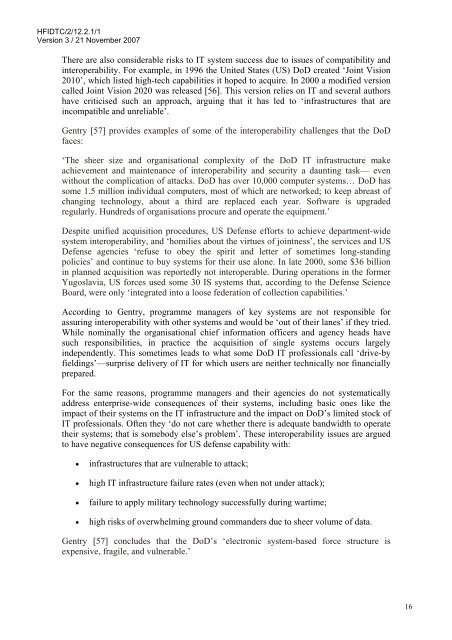The Impact of Technology Insertion on Organisations
The Impact of Technology Insertion on Organisations
The Impact of Technology Insertion on Organisations
You also want an ePaper? Increase the reach of your titles
YUMPU automatically turns print PDFs into web optimized ePapers that Google loves.
HFIDTC/2/12.2.1/1<br />
Versi<strong>on</strong> 3 / 21 November 2007<br />
<str<strong>on</strong>g>The</str<strong>on</strong>g>re are also c<strong>on</strong>siderable risks to IT system success due to issues <str<strong>on</strong>g>of</str<strong>on</strong>g> compatibility and<br />
interoperability. For example, in 1996 the United States (US) DoD created ‘Joint Visi<strong>on</strong><br />
2010’, which listed high-tech capabilities it hoped to acquire. In 2000 a modified versi<strong>on</strong><br />
called Joint Visi<strong>on</strong> 2020 was released [56]. This versi<strong>on</strong> relies <strong>on</strong> IT and several authors<br />
have criticised such an approach, arguing that it has led to ‘infrastructures that are<br />
incompatible and unreliable’.<br />
Gentry [57] provides examples <str<strong>on</strong>g>of</str<strong>on</strong>g> some <str<strong>on</strong>g>of</str<strong>on</strong>g> the interoperability challenges that the DoD<br />
faces:<br />
‘<str<strong>on</strong>g>The</str<strong>on</strong>g> sheer size and organisati<strong>on</strong>al complexity <str<strong>on</strong>g>of</str<strong>on</strong>g> the DoD IT infrastructure make<br />
achievement and maintenance <str<strong>on</strong>g>of</str<strong>on</strong>g> interoperability and security a daunting task— even<br />
without the complicati<strong>on</strong> <str<strong>on</strong>g>of</str<strong>on</strong>g> attacks. DoD has over 10,000 computer systems… DoD has<br />
some 1.5 milli<strong>on</strong> individual computers, most <str<strong>on</strong>g>of</str<strong>on</strong>g> which are networked; to keep abreast <str<strong>on</strong>g>of</str<strong>on</strong>g><br />
changing technology, about a third are replaced each year. S<str<strong>on</strong>g>of</str<strong>on</strong>g>tware is upgraded<br />
regularly. Hundreds <str<strong>on</strong>g>of</str<strong>on</strong>g> organisati<strong>on</strong>s procure and operate the equipment.’<br />
Despite unified acquisiti<strong>on</strong> procedures, US Defense efforts to achieve department-wide<br />
system interoperability, and ‘homilies about the virtues <str<strong>on</strong>g>of</str<strong>on</strong>g> jointness’, the services and US<br />
Defense agencies ‘refuse to obey the spirit and letter <str<strong>on</strong>g>of</str<strong>on</strong>g> sometimes l<strong>on</strong>g-standing<br />
policies’ and c<strong>on</strong>tinue to buy systems for their use al<strong>on</strong>e. In late 2000, some $36 billi<strong>on</strong><br />
in planned acquisiti<strong>on</strong> was reportedly not interoperable. During operati<strong>on</strong>s in the former<br />
Yugoslavia, US forces used some 30 IS systems that, according to the Defense Science<br />
Board, were <strong>on</strong>ly ‘integrated into a loose federati<strong>on</strong> <str<strong>on</strong>g>of</str<strong>on</strong>g> collecti<strong>on</strong> capabilities.’<br />
According to Gentry, programme managers <str<strong>on</strong>g>of</str<strong>on</strong>g> key systems are not resp<strong>on</strong>sible for<br />
assuring interoperability with other systems and would be ‘out <str<strong>on</strong>g>of</str<strong>on</strong>g> their lanes’ if they tried.<br />
While nominally the organisati<strong>on</strong>al chief informati<strong>on</strong> <str<strong>on</strong>g>of</str<strong>on</strong>g>ficers and agency heads have<br />
such resp<strong>on</strong>sibilities, in practice the acquisiti<strong>on</strong> <str<strong>on</strong>g>of</str<strong>on</strong>g> single systems occurs largely<br />
independently. This sometimes leads to what some DoD IT pr<str<strong>on</strong>g>of</str<strong>on</strong>g>essi<strong>on</strong>als call ‘drive-by<br />
fieldings’—surprise delivery <str<strong>on</strong>g>of</str<strong>on</strong>g> IT for which users are neither technically nor financially<br />
prepared.<br />
For the same reas<strong>on</strong>s, programme managers and their agencies do not systematically<br />
address enterprise-wide c<strong>on</strong>sequences <str<strong>on</strong>g>of</str<strong>on</strong>g> their systems, including basic <strong>on</strong>es like the<br />
impact <str<strong>on</strong>g>of</str<strong>on</strong>g> their systems <strong>on</strong> the IT infrastructure and the impact <strong>on</strong> DoD’s limited stock <str<strong>on</strong>g>of</str<strong>on</strong>g><br />
IT pr<str<strong>on</strong>g>of</str<strong>on</strong>g>essi<strong>on</strong>als. Often they ‘do not care whether there is adequate bandwidth to operate<br />
their systems; that is somebody else’s problem’. <str<strong>on</strong>g>The</str<strong>on</strong>g>se interoperability issues are argued<br />
to have negative c<strong>on</strong>sequences for US defense capability with:<br />
• infrastructures that are vulnerable to attack;<br />
• high IT infrastructure failure rates (even when not under attack);<br />
• failure to apply military technology successfully during wartime;<br />
• high risks <str<strong>on</strong>g>of</str<strong>on</strong>g> overwhelming ground commanders due to sheer volume <str<strong>on</strong>g>of</str<strong>on</strong>g> data.<br />
Gentry [57] c<strong>on</strong>cludes that the DoD’s ‘electr<strong>on</strong>ic system-based force structure is<br />
expensive, fragile, and vulnerable.’<br />
16

















